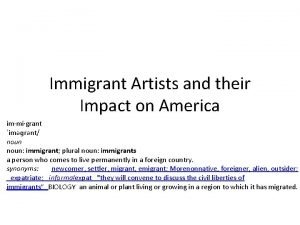Healthy Immigrant Effect Population Indicators of Immigrant Mental



















- Slides: 19

Healthy Immigrant Effect? Population Indicators of Immigrant Mental Health in the 2010 Canadian Community Health Survey Peter Kellett MN RN Ph. D. Student - Demography Prentice Institute for Global Population and Economy Academic Assistant/Instructor -Nursing Faculty of Health Sciences University of Lethbridge

Background v. Immigration is the biggest contributor to Canadian population growth – more than 250 000 annually (Statistics Canada, 2010). v. Diversity of immigrants is increasing – more immigrants from Asia, the Middle East, the Caribbean, and Africa (Nguyen et al. , 2011; Pottie et al. , 2008). v On average recent immigrants are in better overall health when compared to the Canadian -born (“Healthy Immigrant Effect”) This effect starts to decline in as little as 2 years after arrival (Beiser, 2005; De Maio, 2010; De Maio & Kemp, 2010; Newbold, 2009; Nguyen, et al. , 2011).

Research Objective To describe the current state of Canadian immigrants’ mental health through analysis of the 2010 public use Canadian Community Health Survey (CCHS) data. Research Questions 1. How does Canadian immigrants’ mental health compare to the Canadian-born? 2. Is there a healthy immigrant effect for mental health? 3. Is there a difference in immigrant mental health status based on gender, duration of residence in Canada, and cultural or racial origin?

Method Sample 2010 Canadian Community Health Survey (CCHS) v. Annual cross-sectional survey collecting data on health status, health care utilization, and health determinants v. Self-report data (in person or via telephone) v. Representative sample of Canadians 12 years & up v. Public use file contains data on (n=62 909) v. Immigrant Canadians (n=8848) v. Accessed through Statistics Canada Data Liberation Initiative Analysis (Statistics Canada, 2011) v. Subjected to statistical analysis using IBM SPSS Version 20. 0 v. Tests of difference (Independent t-tests, Mann Whitney U, ANCOVA) v. Multiple Regression v. Logistic Regression (weighted) v. Calculation of Odds Ratios

Findings v v v Perceived Mental Health (0=Poor, 2=Good, 3=Very Good, 4= Excellent) Immigrants had significantly higher self-reported ratings of mental health No significant difference noted based on gender Recent immigrants had significantly better selfreported ratings of mental health when compared with those in Canada for greater than 10 years. Within these groups – no significant difference based on gender No significant difference based on cultural or racial origin Perceived Mental Health Variable Immigrant Yes No Immigrant – Sex Male Female Immigrant – Length of Time in Canada 0 -9 Years 10+ Years Immigrant – Length of Time in Canada – Sex Male (0 -9 Years) Female (0 -9 Years) Male (10+ Years) Female (10+ Years) Immigrant – Cultural or Racial Origin White Visible Minority _______________ N M SD Skew Test Statistic 8608 3. 02 . 932 -. 693 t (11663. )= 51397 2. 99 . 930 -. 676 3. 310** 3770 3. 04 . 938 -. 704 t (8058)= 4838 3. 01 . 928 -. 685 1. 242 1868 3. 15 . 869 -. 730 t (8606)= 6740 2. 99 . 946 -. 673 6. 837*** 858 3. 16 . 870 -. 684 t (1866)= 1010 3. 15 . 868 -. 770 . 412 2912 3. 00 . 954 -. 695 t (6738)= 3828 2. 98 . 940 -. 657 1. 01 4928 3. 02 . 941 -. 708 t (8566)= 3640 3. 03 . 921 -. 677 -. 682 Note. N= Sample Size; M = Mean; SD= Standard Deviation; Skew= Skewness Statistic; t= Independent t-test; * Statistically significant at 0. 05 level; ** Statistically significant at 0. 01 level; *** Statistically significant at <0. 001 level

Multiple Regressiona Results for Perceived Mental Health among Immigrant Canadians Perceived Mental Health __________________ v The following variables were significant predictors of positive perceived mental health among Canadian immigrants v Increased sense of belonging to the community v Increased self-esteem v Being a visible minority v Being a recent immigrant (< 9 yrs) v Higher household income v Higher education levels v Increased social support These findings are consistent with those of previous studies that have also found these variable to have an influence on the mental health of immigrants (Ali, 2002; De Maio, 2010; De Maio & Kemp, 2010; Newbold, 2009; Nguyen, et al. , 2011; Zheng & Schimmele, 2005) Model only makes a small 13. 6% contribution to the variance in the perceived mental health variable Sense of Belonging to the Community Self-esteem Scale Cultural or Racial Origin Length of Time in Canada -. 117*** -. 107 Squared Semi Partial Correlations (sri 2). 0125 . 085***. 121* -. 207*** . 261. 066 -. 096 . 066. 0037. 0074 Total Household Income Education Level Social Support Availability . 043*. 124* -. 717*** . 065. 058 -. 092 . 0037. 0035. 0079 Sex Age Languages –Can Speak Common Law Widowed/Separated/ Divorced Single – Never Married CONSTANT . 058. 016 -. 177. 072 -. 036 . 032. 064 -. 035. 019 -. 015 . 0021. 0013. 0004. 0002 Variable Regression Standardized Coefficients Regression (B) Coefficients (β) . 022. 010. 00006 1. 684*** _________________ R=. 377 and Adjusted R 2=. 136 Note. a Variables Entered Simultaneously; ; * p<0. 05; **p<0. 01; ***p<0. 001

Composite International Diagnostic Interview – Short Form for Major Depression (CIDI-SF-MD) – Predicted Probability • • Provides a probability between 0. 0 and 0. 9 of receiving a diagnosis of depression if the full CIDI questionnaire was completed Reliable and valid instrument based on the DSM diagnostic criteria for depression v Immigrants had a significantly lower predicted probability of depression v No significant differences noted based on gender v Recent immigrants (< 9 yrs) had significantly lower predicted probability of depression, and there was no significant difference in probability based on gender v There was no difference in the predicted probability of depression based on cultural or racial origin CIDI-SF-MD Predicted Probability _______________ N M SD Skew Test Statistic Variable Immigrant Yes No Immigrant – Sex Male Female Immigrant – Length of Time in Canada 0 -9 Years 10+ Years 3628 . 059 . 215 3. 48 24501 . 069 . 231 3. 17 1636 . 053 . 204 3. 70 1992 . 063 . 223 3. 33 927 . 044 . 188 4. 124 2701 . 064 . 223 3. 314 . 050 . 197 3. 83 . 040 . 180 4. 44 . 055 . 207 3. 65 . 071 . 235 3. 09 1895 . 063 . 221 3. 34 1720 . 054 . 207 3. 67 Immigrant – Length of Time in Canada – Sex 437 Male (0 -9 Years) Female (0 -9 Years) 490 Male (10+ Years) 1199 Female (10+ Years) 1502 Immigrant – Cultural or Racial Origin White Visible Minority U= 44 971 987* U= 1 647 287 U=1 283 700* U=105 932. 5 U= 916 374 U=1 613 586 Note. N= Sample Size; M = Mean; SD= Standard Deviation; Skew= Skewness Statistic; U = Mann Whitney U; * Statistically significant at 0. 05 level; ** Statistically significant at 0. 01 level; *** Statistically significant at <0. 001 level

CIDI-SF-MD Predicted Probabilityb Multiple Regressiona Results for CIDI-SF-MD Predicted Probability among Immigrant Canadians __________________ Sense of Belonging to the Community Self-esteem Scale Cultural or Racial Origin . 010 Standardized Regression Coefficients (β). 038 -. 007** -. 031* -. 083 -. 068 . 0064. 0035 Length of Time in Canada . 050** . 095 . 0066 Total Household Income -. 006 -. 035 . 00096 Education Level Social Support Availability . 007. 153 . 013. 080 . 00017. 0053 Sex Age Languages –Can Speak Common Law Widowed/Separated/ Divorced Single – Never Married CONSTANT . 022 -. 009***. 030 -. 019. 031 . 049 -. 151. 024. 023. 054 . 002401. 010609. 00053. 0004. 0022 Variable Significant predictors of increased depression probability among Canadian immigrants included: v Decreased self-esteem v Being White v Increased length of time in Canada (10+ yrs) v Younger age Note that this model only contributes 3. 6% to the predicted probability of depression Consistent with the findings of Ali (2002) which reported that patterns of depression among immigrants were relatively unaffected by demographic and socioeconomic characteristics Regression Coefficients (B) Squared Semi. Partial Correlations (sri 2). 0014 -. 011 -. 020. 00029. 097 _________________ R=. 207 and Adjusted R 2=. 036 Note. a Variables Entered Simultaneously; b Variable CIDI-SF-MD Predicted Probability is significantly positively skewed and was not transformable; * p<0. 05; **p<0. 01; ***p<0. 001

Seriously Considered Suicide (yes/no) v. Immigrants were significantly less likely to experience suicidal ideation v. Odds of suicidal ideation was not significantly different based on gender (different from adjusted OR) v. Visible minority immigrants were at reduced risk of suicidal ideation (Clarke et al. , 2008) v. Married immigrants were at reduced risk of suicidal ideation v. Widowed/Separated/Divorced and single immigrants were at increased risk v. No significant difference in risk based on education level or ability to converse in one of the official languages Seriously Considered Suicide Yes/No ___________ Variable Immigrant Yes No Immigrant –Sex Male Female Immigrant -Length of Time in Canada 0 -9 Years 10+ Years Immigrant - Cultural or Racial Origin White Visible Minority Immigrant – Married Yes No Immigrant – Common Law Yes No Immigrant – Widowed/ Separated/ Divorced Yes No Immigrant – Single Yes No Immigrant - Education Level Secondary School or Less Some Post-secondary to Postsecondary Graduation Immigrant - Languages Can Speak English or French Other OR 95% CI . 680* 1. 074* [. 539 -. 745] [1. 051 - 1. 097] . 897 1. 084 [. 748 - 1. 077] [. 956 - 1. 228] . 605* 1. 111* [. 414 -. 885] [1. 045 – 1. 180] 1. 245*. 723* [1. 114 - 1. 391] [. 587 -. 890] . 730* 1. 381* [. 615 -. 868] [1. 207 – 1. 581] 1. 351. 988 [. 664 – 2. 752] [. 957 – 1. 021] 1. 364*. 905* [1. 067 – 1. 743] [. 823 -. 994] 1. 408*. 914* [1. 074 – 1. 847] [. 840 -. 995] . 851 1. 059 [. 651 -. 971] [. 971 – 1. 156] 1. 023. 700 [. 988 – 1. 060] [. 364 – 1. 344] Note. OR= Odds Ratio (unadjusted); CI= Confidence Interval; * Significant at 0. 05 level

Seriously Considered Suicide Yes/No Logistic Regression of Variables Differentiating Immigrants’ Suicidal Ideation v Significant predictors of suicidal Variable ideation included v increasing age (Melenfant, 2004) v being female (interesting finding) v increased sense of belonging v increased self-esteem v being white (Clarke et al. , 2008) v being widowed/separated/ divorced Age v. Length of time in Canada, total household income, social support availability, education level, ability to speak one of the two official languages, and being married or common law were not significant predictors v. Note that this model only accounted for 10% of the likelihood of suicidal ideation –other 90% unexplained ________________________ ___ Regression Adjusted Odds Ratios Coefficients Wald Statistics [95% CI] (β). 058 5. 282* 1. 060 [1. 009 – 1. 114] Sex -. 553 Sense of Belonging in -. 175 Community Self-Esteem Scale. 060 19. 673*** 5. 885* . 575. 839 8. 332** 1. 061 [1. 019 – 1. 105] Length of Time in Canada Cultural or Racial Origin Total Household Income Social Support Availability Education -. 197 1. 226 . 821 . 674 20. 876*** 1. 962 [1. 469 – 2. 619] . 035 . 460 1. 035 [. 936 – 1. 145] -. 559 . 965 . 572 [. 187 – 1. 745] -. 219 2. 104 . 803 [. 597 – 1. 080] Languages Can Speak. 106 . 141 1. 112 [. 639 – 1. 934] Married -. 165 . 753 . 848 [. 583 – 1. 231] Common Law -. 320 1. 067 . 726 [. 395 – 1. 333] 16. 403*** . 431 [. 287 -. 648] . 440 . 507 Widowed/Separated/ -. 841 Divorced Constant -. 593 [. 450 -. 734] [. 728 -. 967] [. 579 – 1. 164] Note. Nagelkerke R 2=. 100; a Variable weighted so both groups were given equal weighting in the analysis; * p<0. 05; **p<0. 01; ***p<0. 001

Although suicide rates are generally low among Canadian immigrants, other research suggests that immigrants from different origin groups may experience different trajectories and rates across generations (Hansson et al. , 2012). v

Putting these results in context v These results are suggestive that there is a “healthy immigrant effect” for mental health that declines over time; however, these findings should be viewed with caution – Self-report data for mental health is open to error – due to stigma – This effect may be enhanced among men because admitting emotional distress is inconsistent with common constructions of acceptable masculinity performance (Oliffe & Philips, 2008). – CIDI-SF-MD is based on DSM criteria which outlines depressive symptoms as described by a primarily westernized and medicalized perspectives on depression. Some evidence to suggest that these criteria are culturally and gender biased and that individuals from non-westernized countries may present with different (e. g. somatic) symptoms (Caetano, 2011; Cooksey& Brown, 1998; Oliffe & Philips, 2008; Oliffe et al. , 2010; Wright & Owens, 2001) v Is the “healthy immigrant effect” genuine in the case of mental illness, or is this an artifact of survey instruments and diagnostic criteria that articulate a westernized social construction of mental distress – decreasing the sensitivity in identifying mental and emotional distress among immigrants from nonwesternized countries? • Although these regression models include many common variables known to be related to mental health/illness, they appear to only contribute to relatively small effect on perceived mental health, depression probability, and suicidal ideation among immigrants to Canada. – Clearly there are other factors that contribute in a larger way to the expression of mental health/illness among immigrants

Limitations to Study v The 2010 public-use CCHS data set does not include variables to identify the country or region of origin; therefore, this analysis has treated immigrants to Canada as a homogenous group – problematic as immigrants are certainly a heterogeneous group v Although the sample frame for the CCHS is generally representative of the Canadian population, this survey does exclude individuals living on Crown Lands or Indian reserves, institutional residents, full-time members of the Canadian Forces, and residents of some remote regions

Implications for Future Research v It may be beneficial to explore other measures of mental health and illness that could be better at identifying the mental and emotional distress of our diversifying Canadian population in future national surveys v There may be a need to develop new survey instruments to assess mental health at a population level and these new instruments will need to be tested for reliability, sensitivity, and specificity. v It is striking only 10 – 16 % of these outcomes could be predicted by these common demographic and social criteria included in the models. Additional research is needed to identify the additional factors that contribute to positive mental health outcomes among Canadian immigrants v How much is related to the barriers to successful arrival faced by immigrants? v How much of the decline in the “healthy immigrant effect” is due to acculturation? To a change in their social construction of concepts like depression? To a change in perspective? To the cultural influences of their country of origin? v This situation illustrates the importance of contextualizing the interpretation of statistics in the wider social science context supports usefulness of mixed -methods and multi-disciplinary studies

Acknowledgments Thank you to Dr. Olu Awosoga and Dr. Robert Williams from the Faculty of Health Sciences for their guidance during the statistical analysis Thank you to my Ph. D. committee members Dr. Susan Mc. Daniel (co-supervisor) – Prentice Institute Dr. Brad Hagen (co-supervisor) – Faculty of Health Sciences Dr. Olu Awosoga – Faculty of Health Sciences Dr. Raphael Lencucha – Faculty of Health Sciences

Questions?

References Ali, J. (2002). Mental health of Canada's immigrants. Health Reports, 13 (Supplement), 1 -11. Beiser, M. (2005). The health of immigrants and refugees in Canada. Canadian Journal of Public Health, 96, S 30 -44. Caetano, R. (2011). There is potential for cultural and social bias in DSM-V. Addiction, 106(5), 885 -887. doi: 10. 1111/j. 1360 -0443. 2010. 03308. x Clarke, D. E. , Colantonio, A. , Rhodes, A. E. , & Escobar, M. (2008). Pathways to suicidality across ethnic groups in Canadian adults: the possible role of social stress. Psychological Medicine, 38(3), 419 -431. Cooksey, E. C. , & Brown, P. (1998). Spinning on its axes: DSM and the social construction of psychiatric diagnosis. International Journal of Health Services, 28(3), 525 -554. De Maio, F. G. (2010). Immigration as pathogenic: a systematic review of the health of immigrants to Canada. International Journal for Equity in Health, 9, 20 p. De Maio, F. G. , & Kemp, E. (2010). The deterioration of health status among immigrants to Canada. Global Public Health, 5(5), 462 -478. doi: 10. 1080/17441690902942480 Hansson, E. K. , Tuck, A. , Lurie, S. , & Mc. Kenzie, K. (2012). Rates of mental illness and suicidality in immigrant, refugee, ethnocultural, and racialized groups in Canada: a review of the literature. [; Research Support, Non-U. S. Gov't]. Canadian journal of psychiatry. Revue canadienne de psychiatrie, 57(2), 111 -121. Malenfant, E. C. (2004). Suicide in Canada's immigrant population. [Comparative Study; ]. Health reports / Statistics Canada, Canadian Centre for Health Information = Rapports sur la sante / Statistique Canada, Centre canadien d'information sur la sante, 15(2), 9 -17. Newbold, B. (2009). The short-term health of Canada's new immigrant arrivals: evidence from LSIC. . . Longitudinal Survey of Immigrants to Canada. Ethnicity & Health, 14(3), 315336.

Nguyen, H. , Rawana, J. , & Flora, D. (2011). Risk and Protective Predictors of Trajectories of Depressive Symptoms Among Adolescents from Immigrant Backgrounds. Journal of Youth & Adolescence, 40(11), 1544 -1558. doi: 10. 1007/s 10964 -011 -9636 -8 Oliffe, J. L. , & Phillips, M. J. (2008). Men, depression and masculinities: A review and recommendations. Journal of Men's Health, 5(3), 194 -202. Oliffe, J. L. , Kelly, M. T. , Johnson, J. L. , Bottorff, J. L. , Gray, R. E. , Ogrodniczuk, J. S. , et al. (2010). Masculinities and college men's depression: Recursive relationships. Health Sociology Review, 19(4), 465 -477. doi: 10. 5172/hesr. 2010. 19. 4. 465 Pottie, K. , Ng, E. , Spitzer, D. , Mohammed, A. , & Glazier, R. (2008). Language proficiency, gender, and self-reported health: An analysis of the first two waves of the longitudinal survey of immigrants to Canada. Canadian Journal of Public Health, 99(6), 505 -510. Statistics Canada. (2010). Population projections for Canada, provinces and territories (pp. 248). Ottawa: Statistics Canada. (2011). Canadian community health survey (CCHS) annual component: User guide 2010 and 2009 -2010 microdata files (pp. 97). Ottawa, ON. : Statistics Canada. Wright, N. , & Owen, S. (2001). Feminist conceptualizations of women's madness: a review of the literature. [Article]. Journal of Advanced Nursing, 36(1), 143 -150. Zheng, W. , & Schimmele, C. M. (2005). The healthy migrant effect on depression: Variation over time? [Article]. Canadian Studies in Population, 32(2), 271 -295.

Distress Scale K 10 Distress Scale – proven to have a high degree of sensitivity in the identification of nonspecific stress v Immigrants had significantly lower K 10 distress scores than the Canadian-born v Immigrant women had significantly higher distress scores than immigrant men v No significant differences in distress score based on length of residence in Canada v No significant differences were noted in distress scale scores based on cultural or racial origin Variable Immigrant Yes No Immigrant – Sex Male Female _______________ N M SD Skew Test Statistic 1844 4. 07 4. 98 . 137 b t (2218)= 17874 4. 44 5. 06 -. 001 b -4. 513*** 860 3. 83 4. 92 . 220 b t (1842)= 984 4. 28 5. 02 . 066 b -2. 51* 4. 14 4. 72 . 102 b t (1842)= 4. 04 5. 09 . 189 b 1. 53 3. 76 . 389 . 142 t (597)= 4. 51 . 398 -. 095 -1. 02 3. 87 . 417 . 257 t (1317)= 688 4. 18 . 408 . 135 -. 742 946 3. 82 4. 80 . 195 b t (1812)= 892 4. 34 5. 16 . 073 b -1. 688 Immigrant – Length of Time in Canada 577 0 -9 Years 10+ Years 1267 Immigrant – Length of Time in Canada – Sex 281 Male (0 -9 Years) Female (0 -9 Years) 296 Male (10+ Years) Female (10+ Years) 579 Immigrant – Cultural or Racial Origin White Visible Minority Note. N= Sample Size; M = Mean; SD= Standard Deviation; Skew= Skewness Statistic; t= Independent t-test; * Statistically significant at 0. 05 level; ** Statistically significant at 0. 01 level; *** Statistically significant at <0. 001 level; b reported skewness based on lg 10(var+1) transformed Distress K 10 variable
 Social justice definiton
Social justice definiton Peter skrzynecki biography
Peter skrzynecki biography Immigrant power and control wheel
Immigrant power and control wheel This is why people migrate aj+
This is why people migrate aj+ An immigrant is someone who
An immigrant is someone who Cabrini center for immigrant legal assistance
Cabrini center for immigrant legal assistance Journal on healthy food healthy mind
Journal on healthy food healthy mind Healthy soil healthy life poster ideas
Healthy soil healthy life poster ideas Healthy forests healthy communities poster ideas
Healthy forests healthy communities poster ideas Healthy nurse healthy nation
Healthy nurse healthy nation Chapter 4 population ecology section 1 population dynamics
Chapter 4 population ecology section 1 population dynamics Population ecology section 1 population dynamics answer key
Population ecology section 1 population dynamics answer key Population ecology section 1 population dynamics
Population ecology section 1 population dynamics Population ecology section 1 population dynamics
Population ecology section 1 population dynamics Mental health and mental illness chapter 20
Mental health and mental illness chapter 20 Mental health jeopardy game
Mental health jeopardy game Bohr's effect in respiration
Bohr's effect in respiration Founder effect vs bottleneck effect
Founder effect vs bottleneck effect Marshallian demand function
Marshallian demand function Msnas
Msnas





































